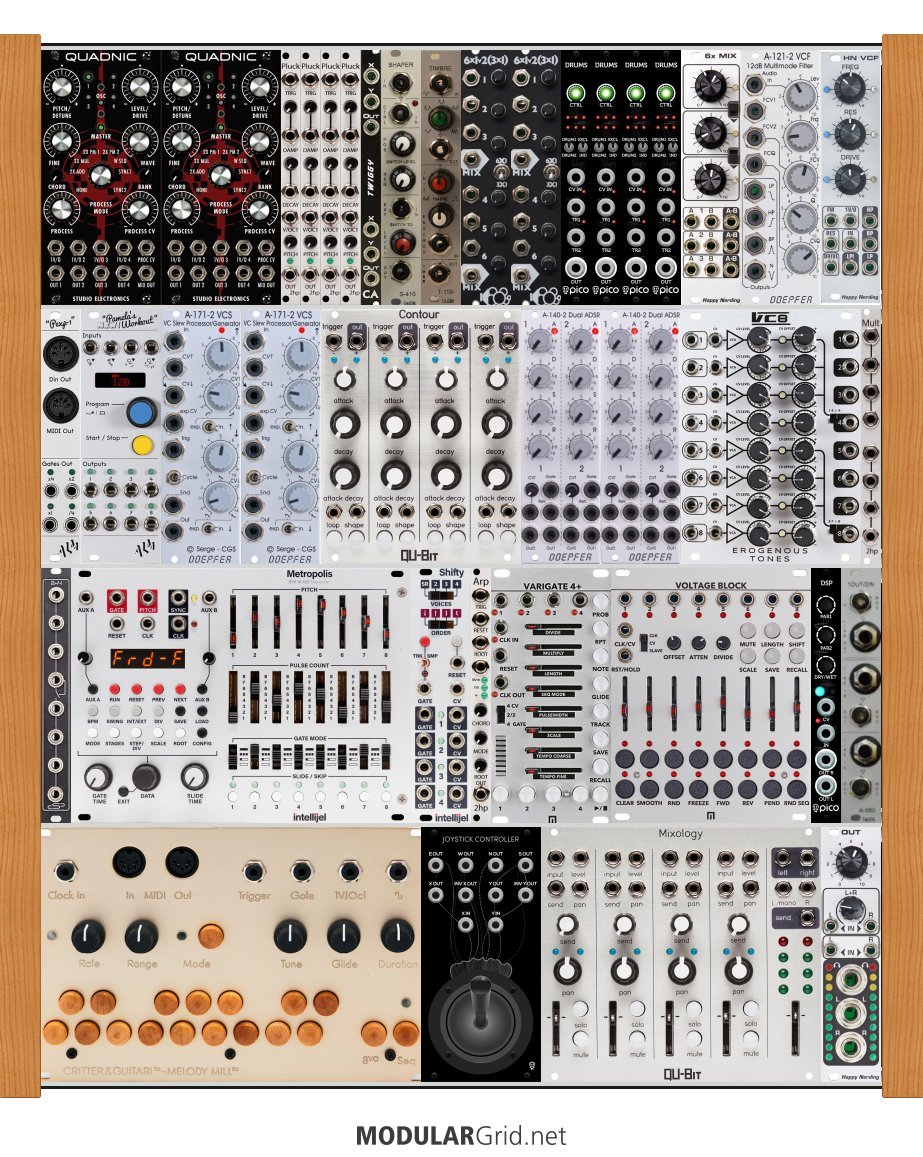
I did some work on this, along with your explanations of what you're trying to do. This should be suitable...
The bottom row is your control surfaces: Melody Mill, Mixology, an added joystick, and your stereo out. But you'll notice that, first, there IS a joystick and the output isn't the WMD. Here's why: first, having an extra control for expression, making global changes, and the like is pretty important. I went with a joystick here because it's a bit easier to flick around when playing other instruments. And the Happy Nerding output has the extra plus of an extra stereo pair that can be mixed in with the fixed-level input. That one's useful because, if you look just above it, there's a send-return module, which sends one mono signal and returns a stereo pair. With this, you can put an external processor into the mix as a parallel process.
Next row...multiple, Metropolis (keep that), then a Shifty, your ARP, and a Malekko setup with the Varigate4+ and Voltage Block. The Erica DSP is next to this and the aforementioned send-return next to that, located so that they're convenient to the mixer's AUX i/o and the main output. The Shifty is an analog shift register, which is a variation on a sample and hold that, each time it receives a clock pulse, shifts the stored voltage on one output to the next while loading a new one, and does this X4. This can also build up different sorts of arpeggiations, intricate hocket patterns, etc depending on how you decide to patch it up and makes an interesting tandem with the ARP. The Varigate4+ got added to give you memory for the Voltage Block plus some better/more complex control functions over that module.
Above that is modulation and VCAs. I added the Pexp-1 for the Pamela's to send clocking out from that via either MIDI or DINsync, which makes it easier to run the Pamela's as a master clock for the entire rig instead of just the modular. And yes, the Pamela's is a good choice with envelopes, LFO sync, sequencer clocking, and quite a bit more. The next two modules are Doepfer A-171-2s, which are clones of the Serge VCS (and which also are half of a Maths) and can work as a lot of different modulation sources. They're extremely versatile. The Contour gives you four loopable AR envelopes, which means they can function either as EGs or user-defineable-waveform LFOs. Four more conventional ADSRs are after that, then you'll find an Erogenous Tones VC8, which works both as eight separate linear VCAs or as two sets of four into one mixers with VCA control. These are DC-coupled, which will let them work equally well on CVs as well as audio. Last up, another mult.
Top row: two Quadnics, then four of the 2hp Plucks. This gives you three signals per 'voice' in a four-part paraphonic-type configuration, but also allows for a lot more. Next to that is a dual ring modulator, then two different Ladik waveshaping modules. After this are two Bubblesound mixers that can either be configured as 6 -> 1 or two 3 -> 1s, as needed. These can work for either the audio or CV, as the mixer is DC-coupled. Four of the Erica Drums are next, plus another mixer to combine these as well as have a free 2 -> 1 mixer as needed. Then the filters: a more conventional Doepfer state-variable, and a Happy Nerding state-variable that offers some rather different filter curves.
This is how I'd proceed, given the elements you said you wanted to leave in the original build plus the sort of usage you mentioned. Note also that the Moogs are not in here; they really do belong in their own cases as they take up quite a bit of valuable Eurorack space and, also, they don't exactly conform to all of the Eurorack 'standards' when it comes to CVs and such. Also, with the Pexp-1, you can lock them via a MIDI clock from the Pam's and not worry about taking up any of your gate/trig outputs. All in all, not a bad setup...
[FYI: the ModularGrid picture-mangling software seems to be working optimally once more, and I had to engage in a bit of a struggle to get (I hope) the right image up. If you see two VCF modules in the upper-right corner, then you're looking at the actual final version.]
